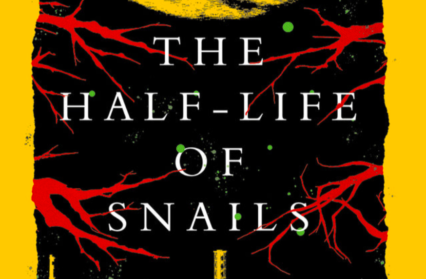Zoe Kramer reviews The Half-Life of Snails by Philippa Holloway, exploring sororal relations and motherhood while dealing with questions of nuclear power and a trip taken to Chernobyl’s Exclusion Zone.
The Half-Life of Snails feels almost eerily relevant when watching developments in the war in Ukraine, with its Chernobyl setting and themes of displacement and territory during the 2014 Euromaidan revolution. However, to describe this novel only through its pertinence to the current global stage would be doing it a disservice. Indeed, it has much more to offer.
The book follows Helen, a single mother and nuclear disaster prepper, on her journey to Chernobyl. A foil to Helen is her sister Jennifer, who works at the Wylfa power station in North Wales. Though opposite in many ways, the sisters are both marked by their non-conformity as women and both undergo journeys of self-discovery. Helen is a single mother and active in her pursuit of a future for her son. Jennifer is a working woman who has no desire to have children whatsoever, making her a non-conforming woman in a different way. It is fascinating to watch as both sisters begin to question their world-views.
Helen is acutely aware of herself as an outsider in Chernobyl. She visits on a tour bus, and every tourist has a different reason for visiting. Some compare the abandoned landscape to their favourite video games, while others are there to document. Helen feels a connection to the land as she notices the ways in which the agrarian landscape mirrors her own familiar north Wales home. Holloway does an excellent job of bridging the distance between these two cultures, with striking similarities not only in the landscapes themselves, but in the closeness and the reverence towards the landscape that different characters have.
The landscapes are also marked by the passage of time. The concept of a half-life is prevalent throughout the novel, speaking to an emptiness that Helen feels in being separated from her family and home. It also speaks to the disconnection between the lives of isotopes and the comparably miniscule lifespans of the human characters. It is this quality which makes the novel adept at addressing the climate crisis, because while it is attuned to the characters, the bigger picture of the earth’s experience is always omnipresent in the background. Meanwhile, Jennifer looks after Helen’s son Jack in her absence. Jack is not your average five year old, preferring roaming the outdoors to games, and snails to friends. Noting Jack’s behaviours, Jennifer begins to call into question Helen’s parenting abilities. However, the book does not lead the reader towards one conclusion or another – it is in these grey areas that the book does its best work.
Another of these grey areas is formed by the sisters’ reactions to the nuclear power station. Helen focuses on the risk it poses, the potential for the disaster and the displacement that would occur in building it. Jennifer focuses on the benefits for the economy, and the stability it brings for her family. However, she has her fears as well. Following a nuclear safety drill, Jennifer is struck by the disastrous consequences that could occur from a simple human error. Both her and Helen share anxiety about it, but this anxiety manifests itself in different ways. The writing maintains its objectivity, however, never giving away a subtle preference to one view or the other, but leaving the reader to gather their own reflections on a matter of great complexity and nuance.
The subject on which the book perhaps speaks most profoundly is on the idea of home. It explores the displacement that happens around nuclear power, both in times of peace and in times of disaster. It is the power that drives an older generation to reclaim their homes in Chernobyl despite every warning not to. It is the driving force behind Helen’s prepper tendencies, and what pushes her to her very limits.The Half-Life of Snails is a gripping story which speaks to a universal anxiety, not just about nuclear power, but about the environment as a whole. It explores the way we respond in crisis, and the things we hold onto most when everything seems under threat. More than that, it captures the genuine love of a family who, despite their flaws, care about one another deeply. A transformative read in a time of heightened complexity and division.
The Half-Life of Snails by Philippa Holloway is available now – all proceeds from the book go to the Ukraine appeal.











